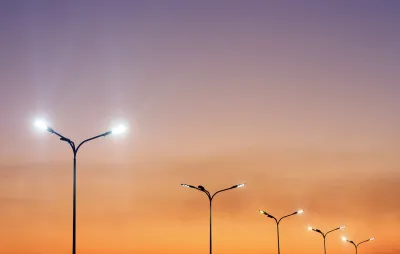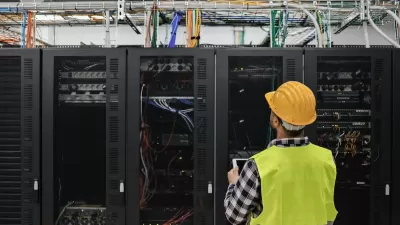Switching to energy-efficient LEDs and using tech to program when and how street lighting operates can save cities millions in electricity expenses and bring down carbon emissions.

According to an article in Cities Today, smart street lighting technology could help cities reduce their carbon emissions and adjust urban lighting to limit disruption to local ecosystems and human circadian rhythms.
Street lighting is one of the largest sources of energy consumption and emissions under the direct control of cities: public street and area lighting account for up to 40 percent of electricity consumed by municipalities, and for about 1-3 percent of total electricity demand, as reported by The Climate Group.
Smart streetlight management can add another tool to local governments’ toolboxes, the article notes. “The first step is turning streetlights to energy-efficient LED lamps, immediately saving up to 70 percent in power consumption and related costs.”
By using technology to manage when lighting turns on and off and how much energy it uses, cities can save even more. According to the article, “Remote on-off control, dimming, and scheduling functions are quick wins of IoT street lighting solutions, making them one of the most actionable and ready-to-implement technologies for cities to transition to a low-carbon economy.”
FULL STORY: Smart lighting is more than energy saving

Planetizen Federal Action Tracker
A weekly monitor of how Trump’s orders and actions are impacting planners and planning in America.

Congressman Proposes Bill to Rename DC Metro “Trump Train”
The Make Autorail Great Again Act would withhold federal funding to the system until the Washington Metropolitan Area Transit Authority (WMATA), rebrands as the Washington Metropolitan Authority for Greater Access (WMAGA).

The Simple Legislative Tool Transforming Vacant Downtowns
In California, Michigan and Georgia, an easy win is bringing dollars — and delight — back to city centers.

The States Losing Rural Delivery Rooms at an Alarming Pace
In some states, as few as 9% of rural hospitals still deliver babies. As a result, rising pre-term births, no adequate pre-term care and harrowing close calls are a growing reality.

The Small South Asian Republic Going all in on EVs
Thanks to one simple policy change less than five years ago, 65% of new cars in this Himalayan country are now electric.

DC Backpedals on Bike Lane Protection, Swaps Barriers for Paint
Citing aesthetic concerns, the city is removing the concrete barriers and flexposts that once separated Arizona Avenue cyclists from motor vehicles.
Urban Design for Planners 1: Software Tools
This six-course series explores essential urban design concepts using open source software and equips planners with the tools they need to participate fully in the urban design process.
Planning for Universal Design
Learn the tools for implementing Universal Design in planning regulations.
Smith Gee Studio
City of Charlotte
City of Camden Redevelopment Agency
City of Astoria
Transportation Research & Education Center (TREC) at Portland State University
US High Speed Rail Association
City of Camden Redevelopment Agency
Municipality of Princeton (NJ)





























